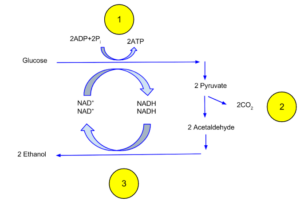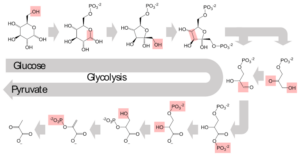Anaerobic respiration is a kind of respiration process which doesn’t require O2 molecule as electron acceptor or simply we can say that anaerobic respiration occurs in absence of Oxygen. Let’s discuss the anaerobic respiration examples briefly.
Anaerobic respiration occurs mostly in prokaryotic cells and sometimes in eukaryotic cells also. Anaerobic respiration examples are –
- Lactic acid production
- Alcohol fermentation
- Methanogenesis or Fermentation in methanogens
- Propionic acid fermentation
Lactic acid production
Lactic acid production is an anaerobic respiration method in which oxygen is not required. In this process respiration begins with the glycolysis process, which means a glucose C6H12O6 molecule breaks and converts into the pyruvate. This reaction releases 2 molecules of ATP. After that the pyruvate breaks and converts into lactic acid C3H6O3 which is a three carbon molecule and releases 2 ATP molecules.
C6H12O6 → C3H6O6 + energy (2ATP)
This process mainly occurs in eukaryotic cells specifically in muscle cells, when due to excessive working, the muscles cells lack oxygen supply. As in this process less amount of energy is released, weakness and shortness of breathing can be seen.
As lactic acid or lactose is produced in this process and stored , it causes sore muscles.

Lactic acid production from Wikimedia Commons
Alcohol fermentation
Alcohol fermentation is another process in which oxygen is not required. Alcohol fermentation mostly occurs in some fungi species like Yeast (Saccharomyces cerevisiae). Same as aerobic respiration, glucose molecules undergo a glycolysis process and convert into pyruvate. After that the yeast converts the pyruvate into ethanol and releases energy. This is one of the Anaerobic respiration examples in which at the end carbon dioxide is released.
C6H12O6 → C2H5OH + CO2 + energy (2ATP)
If we put yeast species and some glucose or carbohydrate substances together and bottled them for some time, the yeast converts into ethanol, an alcohol. That’s why this process is called the alcohol fermentation process.

Anaerobic respiration examples from Wikipedia Commons
To know more read on Are Yeast Multicellular :Why,How And Detailed Insights And Facts
Methanogenesis or Fermentation in methanogens
Methanogens are prokaryotic organisms, undergo anaerobic respiration and produce an alcohol methanol from glucose. Methanogens oxidized cellulose from the plant body breaks it into methanol and releases energy molecules. In this process carbon dioxide is also produced just like the alcohol fermentation process. The difference is instead of ethanol it produces methanol. This methanol is poisonous in nature and even causes death.
C6H12O6 → CH3OH + CO2 + energy
Propionic acid fermentation
In some bacterias carbohydrate molecules break in the absence of Oxygen molecules and convert into acid molecules like propionic acid. This process is known as the propionic acid fermentation process.
C12H22O11 → C3H6O2 + CO2 + energy
There are some bacterias like Propionibacterium shermanii in which the propionic acid fermentation process is found. During cheese production, this process is used widely. The released carbon dioxide causes bubbles in the cheeze.
These are some anaerobic respiration examples in which the oxygen molecule is not used as the electron acceptor. Instead of oxygen anaerobic organisms use components like nitrate (NO3-), fumarate (CH2O24-), sulfate (SO24-), or elemental sulfur (S) at the end of electron transport chain as the final electron acceptor. As these substances have less oxidising capacity and lower energy than oxygen, it releases less energy from the glucose molecule. Due to partial oxidation, Only 5% of the glucose breaks and releases energy.
All anaerobic respiration examples follow the first step of respiration, glycolysis to break the glucose into pyruvate.
( Glucose) C6H12O6→ (Pyruvate) CH3COCOOH

Glycolysis process from Wikimedia Commons
After that it skips Krebs cycle and produces different organic by-products and releases energy. Carbon dioxide may or may not be produced in the final step of anaerobic respiration. In lactic acid fermentation carbon dioxide is not produced but in the alcohol fermentation process carbon dioxide is produced.
The anaerobic respiration occurs in lower groups of organisms like bacteria, fungi, etc. This process is a cellular respiration which takes place in the cytoplasm of the cell.
According to some theory anaerobic respiration and fermentation both generate ATP in absence of Oxygen molecule but are not synonyms meaning they are different from each other. Fermentation can be extracellular but anaerobic respiration is always an intracellular process. In anaerobic respiration examples after glycolysis an electron potential or ion concentration gradient is created but in the fermentation process only substrate level phosphorylation is seen.
To know more read our article on Do Humans Have Animal Cells: Interesting FACTS
In anaerobic respiration examples which substances are used as the last electron acceptor molecule?
Electron transport chain is the last step of the respiration process, when glucose breaks and energy is produced.
In the aerobic respiration process oxygen molecules are used as the last electron acceptor molecule. But in anaerobic respiration process, instead of oxygen different organic and inorganic substances are used as last electron acceptor such as nitrate (NO3–), fumarate (CH2O24-), sulfate (SO24–), or elemental sulfur (S).
What are the chemicals produced in anaerobic respiration process?
In anaerobic respiration process, different inorganic or organic molecules are produced as by-products of reaction.
In the alcohol fermentation process Ethanol is produced. In lactic acid fermentation lactic acid or lactose is produced during reaction. Apart from these methanol, propionic acid, biogases, etc are also produced.
Along with these organic by-products, energy that is ATP molecules genareates. Carbon dioxide may or may not be produced.
How many ATP molecules are produced during anaerobic respiration process?
In anaerobic respiration process Two ATP molecules are produced per glucose molecule.
Here we describe different anaerobic respiration examples respectively. We see how in absence of Oxygen molecule the cellular respiration happens. We also see in some theories how fermentation and anaerobic respiration differs from each other. Hope this article on anaerobic respiration examples will be helpful to you.
To know more read on Nucleotide Examples:Detailed Insights
Also Read:
- Does the krebs cycle produce water
- Is diffusion directional
- Tick characteristics
- Deltoid muscle
- Spherical bacteria examples
- Immiscible liquids
- Aquatic plant example
- Berry fruit examples
- Carbohydrates structure examples
- Plant cell wall formation

Hello, I am Piyali Das, pursuing my Post Graduation in Zoology from Calcutta University. I am very passionate on Academic Article writing. My aim is to explain complex things in simple way through my writings for the readers.